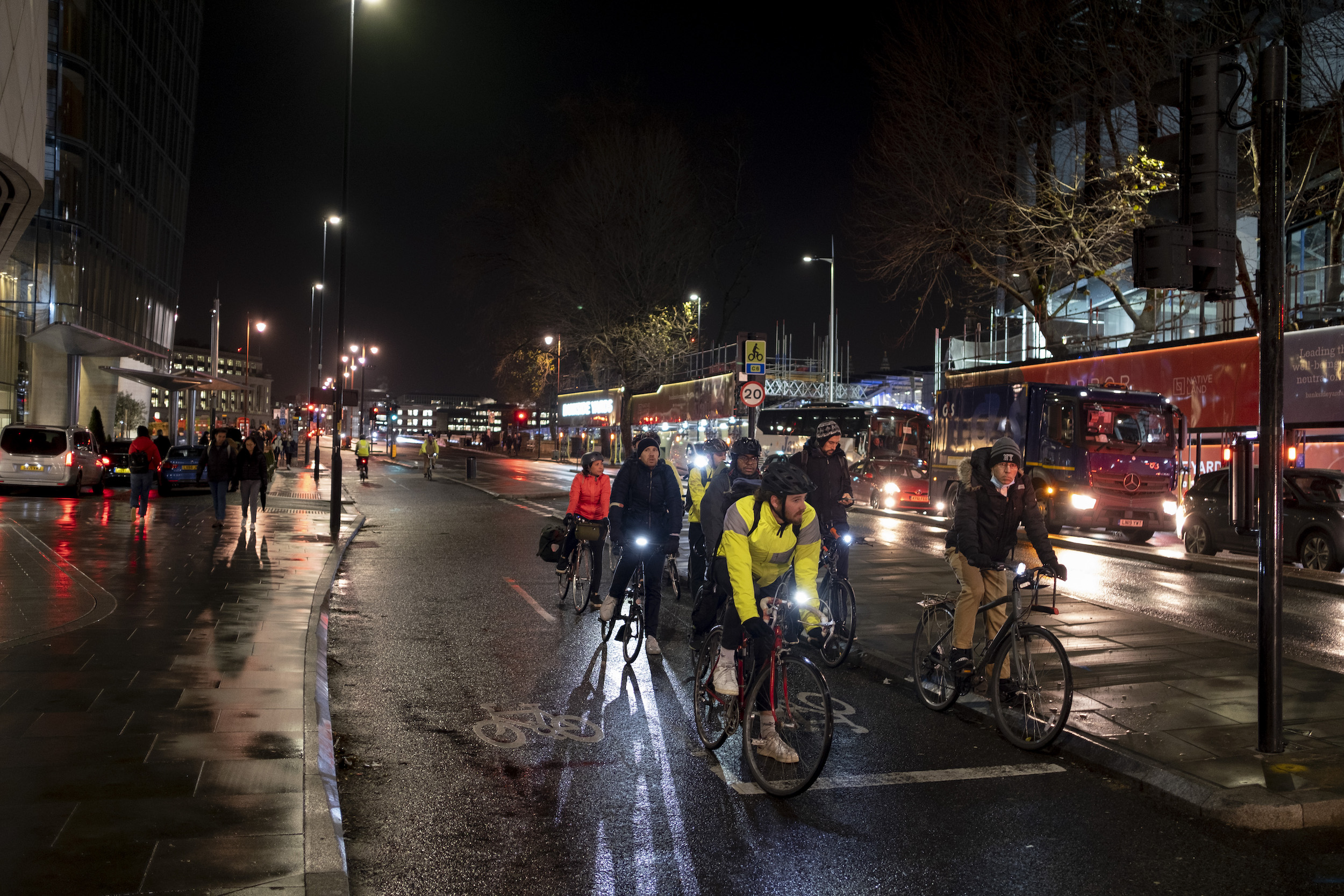What do the changes to the Highway Code really mean for cyclists and drivers?
We delve into the update to bust some common myths about changes to the UK's road rules


As the changes to the Highway Code approach, coming into force on Saturday in England, Scotland and Wales, there have been startling levels of hyperbole and vitriol over what the update actually means.
Column inches, news channels and phone-in radio stations have all been used to decry the new rules, accompanied by high levels of anti-cycling sentiment. The reaction to the fairly tame proposals is what led Groupama-FDJ's Jake Stewart to tweet that "cycling in the UK is doomed".
In the Daily Mail on Tuesday, Richard Littlejohn wrote that transport policy "has been captured by single-issue, anti-car fanatics, hell-bent on bankrupting businesses and causing the maximum possible inconvenience to the travelling public".
Most of the changes will not affect road users too much, and simply codify things that have already been general practice for cyclists for years. Here is Cycling Weekly's myth-busting guide to the new code.
Cyclists "can" ride two abreast, but not three
Some outlets have stated that cyclists will be encouraged to ride two or three abreast. Littlejohn wrote: "Bikers are encouraged to ride two or three abreast in the middle of the road, deliberately to slow traffic to a crawl."
On Good Morning Britain on Tuesday, Graham repeated the falsehood, telling viewers that the rules say you "should" ride two or three abreast.
Instead, the new Highway Code, rule 66, says cyclists should "be considerate of the needs of other road users when riding in groups".
Get The Leadout Newsletter
The latest race content, interviews, features, reviews and expert buying guides, direct to your inbox!
It reads: "You can ride two abreast and it can be safer to do so, particularly in larger groups or when accompanying children or less experienced riders. Be aware of drivers behind you and allow them to overtake (for example, by moving into single file or stopping) when you feel it is safe to let them do so."
The reference to stopping in allowing drivers to overtake has caused concern that club runs will be affected, but it is unlikely that it will change anything in practice.
Cyclists will not be riding in the middle of the road
A Sunday Times headline made out that cyclists will be riding in the "middle of the road." The new Highway Code instead suggests that at certain times, those on bikes can use the centre of the lane. This is nothing new, again, cyclists have been advised to ride in the 'primary position', when it is safer to do so, for some time.
Cyclists are encouraged to ride in the centre of the lane "on narrow sections of road, on quiet roads or streets, at road junctions and in slower-moving traffic".
Adopting this position in situations where there is not space for a driver to overtake can avoid the chance of a dangerous overtake.
This has caused controversy. Neil Greig, the director of policy and research at IAM RoadSmart, a road safety charity, told The Sunday Times: "A lot of drivers are going to think that somebody cycling in the middle of the lane in front of them is doing it to deliberately slow them down. That leads to conflict and road rage and inappropriate overtaking."
However, the new rules make it clear that this is necessary at times for safety. At other times, when "riding on busy roads, with vehicles moving faster than you", cyclists are encouraged to move over to the left of the road, but at least 0.5 metres from the kerb. Common sense, no?
You do not have to use cycle lanes
This one incenses some people, with Nick Ferrari on LBC asking: "Why have I spent all this money building cycle lanes for you if you can't be bothered to use them? I want my money back. I want the road back!"
The truth is, sometimes cycle lanes are inconvenient, unsafe or just not as useful as using a road, and cyclists are perfectly entitled to choose which to use. The Highway Code recognises this, advising people to use lanes when it is safer and easier, but acknowledges that this might depend on experience, skills and situation.
It reads: "While such facilities are provided for reasons of safety, cyclists may exercise their judgement and are not obliged to use them."
Drivers aren't going to be forced to stop on roundabouts
Some commentators have suggested that drivers will be forced to stop on roundabouts to give way to cyclists - not so.
The updated Highway Code simply says: "Do not turn at a junction if to do so would cause the cyclist, horse rider or horse drawn vehicle going straight ahead to stop or swerve. You should stop and wait for a safe gap in the flow of cyclists if necessary. This includes when cyclists are... travelling around a roundabout."
Considerate and common sense practices are codified
The "Hierarchy of Road Users", which places pedestrians at the top, as the most vulnerable, followed by cyclists, with motorists at the bottom, is the headline of the Highway Code changes.
All it means is that those with the most risk in the event of the collision are placed at the top. It does not "remove the need for everyone to behave responsibly" on the road.
The code reads: "Everyone suffers when road collisions occur, whether they are physically injured or not. But those in charge of vehicles that can cause the greatest harm in the event of a collision bear the greatest responsibility to take care and reduce the danger they pose to others."
Common sense ideas like not cutting across cyclists are put into the Highway Code: "Do not turn at a junction if to do so would cause the cyclist, horse rider or horse drawn vehicle going straight ahead to stop or swerve."
Furthermore, drivers about to turn into a junction should now give way to pedestrians “crossing or waiting to cross” that road, which seems natural, but has now been put into the Highway Code.
"Pro-bike extremists" did not write these rules
In the Daily Mail, Littlejohn claimed "pro-bike extremists were given a blank sheet of paper to write their own rules."
The government ran a consultation for 12 weeks between July and October 2020, and the Department for Transport "worked closely with expert stakeholder groups representing different users of the road".
Furthermore, these rule changes should benefit all road users by making this clearer on who has priority, and help society by encouraging people to cycle.
Cyclists are not king
Contrary to the frenzied media response, cyclists do not sit top of the pile, that honour goes to the most vulnerable road user, the pedestrian.
The new Highway Code says cyclists have a responsibility to reduce danger to pedestrians, and should give way when turning at junctions, just like a car would. It also warns cyclists to be considerate of pedestrians and horse riders on shared paths, and recommends the use of a bell.
It suggests that cyclists should wear a helmet, have a bell and wear lightly coloured clothing, but this is advisory.
Furthermore, it reminds cyclists to not skip red lights, which will be good news for those that froth at the mouth about this kind of thing.

Thank you for reading 20 articles this month* Join now for unlimited access
Enjoy your first month for just £1 / $1 / €1
*Read 5 free articles per month without a subscription

Join now for unlimited access
Try first month for just £1 / $1 / €1

Adam is Cycling Weekly’s news editor – his greatest love is road racing but as long as he is cycling, he's happy. Before joining CW in 2021 he spent two years writing for Procycling. He's usually out and about on the roads of Bristol and its surrounds.
Before cycling took over his professional life, he covered ecclesiastical matters at the world’s largest Anglican newspaper and politics at Business Insider. Don't ask how that is related to riding bikes.
-
 Positive signs for UK bike industry as Halfords cycling sales grow
Positive signs for UK bike industry as Halfords cycling sales growRetailer admits that the impact of Donald Trump's tariffs remains to be seen
By Tom Thewlis
-
 'We don't own gravel - it's a community thing': the spirit of gravel is safe, say British Gravel Championship organisers
'We don't own gravel - it's a community thing': the spirit of gravel is safe, say British Gravel Championship organisersCycling Weekly travels to Dalby Forest to ride the championship course and find out where we go from here
By James Shrubsall